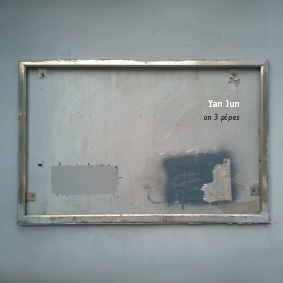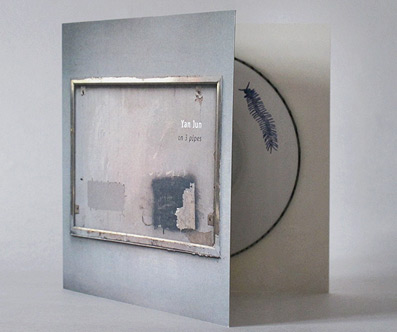
YAN JUN
On 3 Pipes
3“CDR, (22’33’’), 60 copies, printed cardboard cover
1000füssler 030, released in November 2015
7,00 EUR (include shipping)
1, music 1 (8’13’’) mp3 excerpt 1
2, music 2 (14’22’’) mp3 excerpt 2
Track 1 recorded with contact mics on 2 water pipes at home, beijing; between am 7:00 - 8:00, august 10, 2010.
Track 2 recorded with contact mics on 1 water pipe (the Wormhole, number 3) at The Shop, beijing; between pm 4:00 - 5:00, may 14, 2009.
Both tracks were heavily modified during the mastering process. The original materials contain strong noises from the recording equipment. Especially the right channel of track 1.
According to listening to the reality, I believe we have already set up default plug-ins in our ears and brain.
mastered at home, beijing; july 16, 2015.

Yan Jun, born in Lanzhou in 1973. based in Beijing. He is working on improvised music, experimental music, field recording, organizing and writing. Alongside of at venues, he goes to audience's home to play with the environment and what else available. And doing noise hypnotizing at any place for small amount of audiences. Recently also amplifying body movements or other performative elements in a simple manner.
yanjun.org
REVIEWS:
Neural Magazine / Italy
An interesting abstract-experimental 3” CDR is released under the label 1000füssler. Yan Jun is a Beijing-based artist involved at various levels and in different areas of contemporary electronics, from improvisation to site-specific research, from field recordings to noise, a contributor to The Wire and a benchmark for any “audio-abuse” from China. Yan Jun is accustomed to using unstable feedback systems, techniques that modulates several options, from very quiet and delicate treatments to more stinging and extremist performance. On 3 Pipes, a composition divided into two tracks, respectively 8’12 “and 14’21”, belongs to the first type of experimentation, featuring the most sensitive but still vivid recordings generated using contact microphones placed on water pipes (two in the first track, one in the second). Both recordings have been heavily modified during the mastering process and the original materials contain strong noises from the recording equipment, especially the right channel of track 1. Yan Jun informed us about how much the Chinese scene is currently full of new ideas but also afflicted by a now incomprehensible censorship. The transition from traditional music forms, related to folk and ethnic music, to more contemporary evolutions seems to struggle with a problem of freedom and shared cultural experiences, although in the eternal recurrences of an sound genome we can not fail to see that certain primordial elements return, as in a sort of time machine. This approach moves beyond the culture of specific places and regions, beyond stylistic genres, academies and approaches, because something ancestral always hides in even the most contemporary of approaches.
italian version: Pubblica la 1000füssler un interessante 3“ CDR abstract-experimental che si deve alla maestria di Yan Jun, artista di base a Beijing coinvolto a più livelli e in differenti ambiti dell’elettronica contemporanea, dall’improvvisazione alla ricerca site-specific, dalle field recording al noise, collaboratore di The Wire e un punto di riferimento per qualsivoglia “audio-abuso” di provenienza cinese. Yan Jun è avvezzo ad utilizzare sistemi di feedback instabile, tecniche che modula in diverse opzioni, passando da trattamenti molto silenziosi e delicati a performance più urticanti e oltranziste. On 3 Pipes, composizione divisa in due tracce, rispettivamente di 8’12” e 14’21”, appartiene alla prima tipologia di sperimentazioni, quelle più sensibili ma ancora vivide, registrazioni generate usando microfoni a contatto posizionati su condutture d’acqua (due nella prima traccia, una nella seconda). Entrambe le catture auditive sono state pesantemente modificate durante il processo di masterizzazione e i materiali originali contengono forti rumori provenienti dalle attrezzature di registrazione, in particolare il canale destro della traccia 1. Yan Jun, che ultimamente sta inserendo anche elementi performativi nelle sue sperimentazioni, ci ha recentemente edotto tramite alcuni suoi articoli su quanto la scena cinese sia attualmente ricca di spunti ma anche funestata da una censura oramai incomprensibile. Il passaggio da forme musicali tradizionali – legate al folk e alla musica etnica – a più contemporanee evoluzioni, sembra avere a che fare a quelle latitudini anche con un problema di libertà e condivisione d’esperienze culturali, seppure nell’eterno ritorno di un genoma sonoro autoctono non possiamo fare a meno di constatare come certi elementi primigeni ritornino, come in una sorta di macchina del tempo, parlandoci più del carattere e delle consuetudini percettive di luoghi e regioni, travalicando generi stilistici, accademie e approcci: perché anche nella contemporaneità più tendenziosa si nasconde sempre qualcosa di molto ancestrale.
Aurelio Cianciotta, 28. October 2016, http://neural.it
Le Son du Grisli / France
Sans y paraître, les petits disques 1000füssler prennent de plus en plus de place, s’installent dans le paysage mais en toute discrétion. C’est ce que font les deux dernières publications du label, qui datent de novembre dernier : Roshambo (Trio) de Diatribes et Cristián Alvear et On 3 Pipes de Yan Jun. Après l’écoute, et une fois rangés, on les soupçonne même d’enregistrer encore… [...]
A Pékin, c’est un autre trio que Yan Jun fit chanter en deux fois (et modifia bien sûr ensuite) : un tuyau enregistré en 2009 (Track 2), puis deux autres l’année suivante (Track 1). Derrière les sifflements étouffés – ceux du matériel utilisé pour l’enregistrement – de la première plage, entendre un peu d’eau qui circule à différentes vitesses ; derrière la succession de roulements et de (presque) silence de la seconde, c’est cette fois le bruit d’une position : les micros dont se sert Yan Jun révélant à chaque fois la musique d’un intérieur qu’on supposait inaccessible jusqu'à ce que la sonnerie d’un téléphone, atténuée par les parois du tube, ne nous ramène à une réalité, autrement concrète.
Guillaume Belhomme, 2016/06/27 grisli.canalblog.com
Bad Alchemy / Germany
YAN JUN machte in Peking Musik On 3 Pipes (1000füssler 030, 3" mCD-R). Nicht mit Pfeifen, sondern mit Wasserhähnen. Die tropfen und ticken wie Sekundenzeiger, geraten ins Stottern, wuseln wie Tausendfüßler, glucksen und wispern, fangen sich wieder als Uhr oder für einen kleinen Beat, ständig changierend im Tempo. Dazu dröhnt ein feines Surren. Im zweiten Track sind wir dann in der Wasserleitung und deren vibrierendem Stop & Go. In einem Moment druckvoll präsent, im nächsten beinahestill als fernes Funkeln an der Hörschwelle. So mehrfach an und aus. An: Ein mahlendes, pulsierendes Metallic-Vibrato. Aus: Ein ferner Nachhall. An. Aus. Plötzlich klingelt ein Telefon. Will uns das Wasser eine Botschaft schicken?
Rigo Dittmann / Bad Alchemy 89
Vital Weekly / Netherlands
Despite the fact that Yan Jun toured a couple of times in The Netherlands, I missed out on any of these concerts. He hails from China, based in Beijing and his work deals with improvised music, field recordings and such like. The latter is the case with the two pieces on 'On 3 Pipes'. He recorded three water pipes, one at home and one at The Shop, in Beijing. In the first piece the two pipes are separated, one in the left channel and one in the right channel. 'Both tracks were heavily modified during the mastering process. The original noises contain strong noises from the recording equipment. Especially the right channel of track 1', is mentioned on the information. If these are two pipes that were recorded independently from each other than they have some curious coordinated feeling. It's buzzing and dripping throughout. The other piece, at fourteen minutes almost twice as long, is also quite a conceptual piece, which is not always sustaining but rather starts and stops, bouncing between these heavily amplified recording versus the nearly inaudible sounds of the same material. Over the course of the piece the silent bits are more extended and the louder bits get smaller and smaller. Not bad but perhaps a tad too conceptual for my taste.
Frans de Waard / Vital Weekly 1019
www.1000fuessler


